算法基础第二章
- 第二章:数据结构
-
- 1、链表
-
- 1.1、单链表(写邻接表:存储图和树)
- 1.2、双链表(优化某些问题)
- 2、栈与队列
- 2.1、栈
-
- 2.2、队列
-
- 2.2.1、数组模拟队列
- 2.2.2、滑动窗口(单调队列的使用)
- 3、KMP(字符串匹配)
- 4、Trie树(高效地存储和查找字符串集合的数据结构)
- 5、并查集
- 6、堆
- 7、Hash表
-
- 8、STL常用容器(用的时候查一下就行了)
-
- 8.1、vector
- 8.3、pair
- 8.2、string
- 8.3、queue(队尾进队头出,固定方向)
- 8.4、priority_queue(优先队列就是堆,默认是大根堆)
- 8.5、stack
- 8.6 deque(双端队列)
- 8.7 set、map、multiset、multimap(基于平衡二叉树(红黑树),动态维护有序序列)
- 8.8、unordered_set、unordered_map、unordered_multiset、unordered_multimap(哈希表)
- 8.9、bitset
第二章:数据结构
1、链表
- 笔试中遇到需要链表写法解题的话尽量用数组替代,而不是用new创建节点,new非常的费时间
1.1、单链表(写邻接表:存储图和树)
- 解析:如下四句输入,在0前面插入1的时候,0不是链表中的节点,插入链表尾,ne[0]是头指针,里面存着1,意思是头指针指向1节点,整个过程如下图所示。ne保存的是指向下一个元素的位置值,e保存的是自己本身的值。
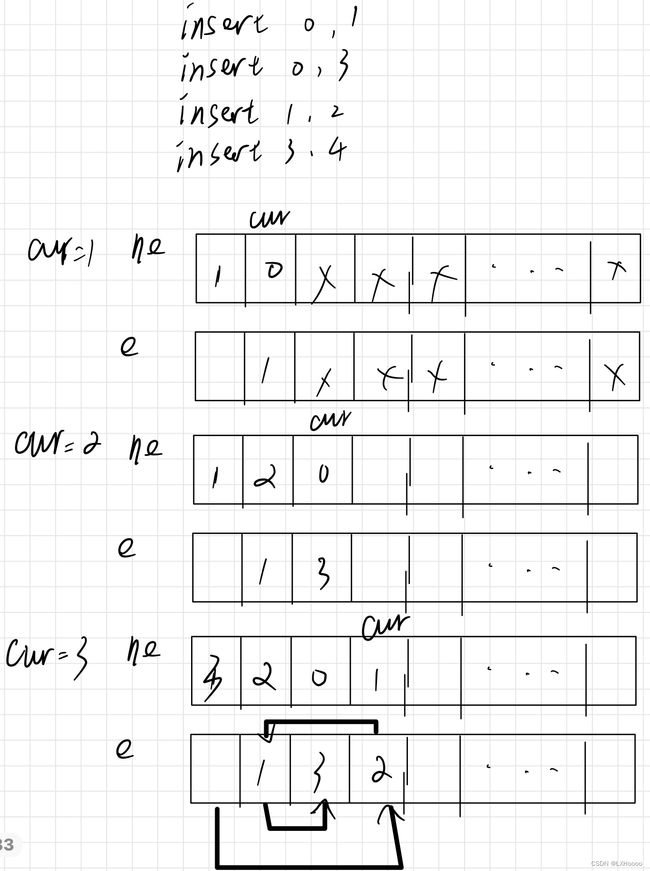
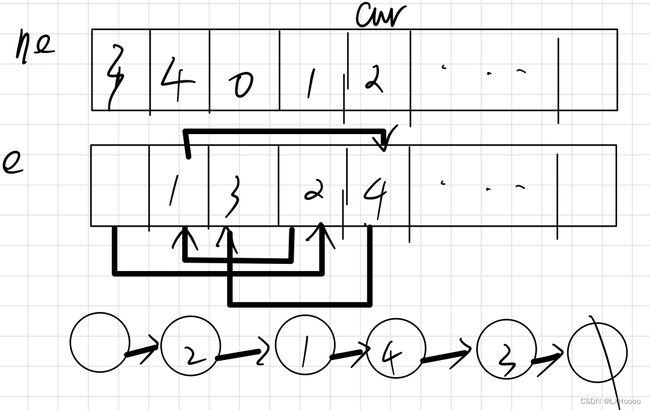
- 题目链接:数组模拟链表
- 代码:这个代码使用了数组,并未使用stl,但并没有全a,后面输入数据过大不给调试,望路过的大佬能够补充
#include
#include
#include
#include
using namespace std;
const int N = 10010;
typedef pair<long long,int>PII;
int n;
PII tmp[N];
long long e[N];
int ne[N];
int cur = 1;
void init()
{
memset(tmp,0x7fffffff,sizeof tmp);
}
int findx(int cur,int x)
{
while(cur>=0)
{
if(tmp[cur].first==x)
{
return tmp[cur].second;
}
cur--;
}
return -1;
}
int findy(int cur,int x)
{
while(cur>=0)
{
if(e[ne[cur]] == x)
{
return cur;
}
cur--;
}
return -1;
}
void insert(int x,int y)
{
auto t = findx(cur,x);
auto u = findy(cur,x);
if(t != -1 && u != -1)
{
e[cur] = y;
ne[cur] = t;
tmp[cur].first = y,tmp[cur].second = cur;
ne[u] = cur,cur++;
}
else {
if(ne[0])
{
e[cur] = y;
tmp[cur].first = y,tmp[cur].second = cur;
ne[cur] = 0;
ne[cur-1] = cur,cur++;
}
else {
e[cur] = y;
ne[0] = cur;
tmp[cur].first = y,tmp[cur].second = cur;
ne[cur] = 0;
cur++;
}
}
}
void del(int x)
{
auto t = findy(cur,x);
auto u = findx(cur,x);
if(t != -1)
{
ne[t] = ne[u];
}
}
int main() {
init();
scanf("%d",&n);
char str[7];
int x,y,z;
while(n--)
{
scanf("%s",str);
if(!strcmp(str,"insert"))
{
scanf("%d%d",&x,&y);
insert(x, y);
}
else {
scanf("%d",&z);
del(z);
}
}
if(ne[0])
{
for(int i=ne[0];i;i=ne[i])
{
printf("%lld ",e[i]);
}
}
else {
printf("NULL");
}
return 0;
}
1.2、双链表(优化某些问题)
2、栈与队列
2.1、栈
2.1.1、数组模拟栈
- 解析:用一个top指针来进行栈的弹出与压入,压栈top加,出栈top减
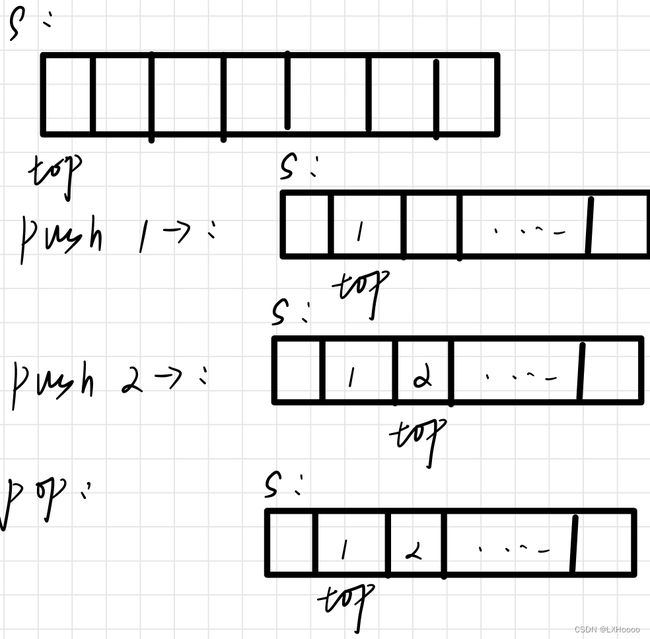
- 题目链接:数组模拟栈
- 代码
#include
#include
#include
#include
using namespace std;
const int N = 100010;
int s[N];
int n;
int top;
int main() {
char opt[5];
int num;
scanf("%d",&n);
for(int i = 0; i < n; i++)
{
scanf("%s",opt);
if(!strcmp(opt,"push"))
{
scanf("%d",&num);
s[++top] = num;
}
else if(!strcmp(opt,"pop"))
{
if(top)
{
printf("%d\n",s[top--]);
}
else {
printf("error\n");
}
}
else {
if(top)
{
printf("%d\n",s[top]);
}
else {
printf("error\n");
}
}
}
return 0;
}
2.1.2、单调栈
- 解析:在一个可能包含重复数字的序列中,找到每个数左边最近比它小的数,栈的压入和弹出如下图所示
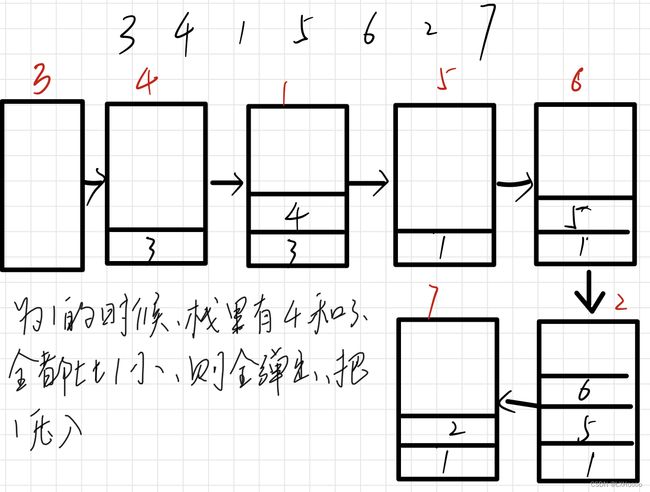
- 题目链接:单调栈的应用
- 代码
#include
class Solution {
public:
vector<vector<int>> foundMonotoneStack(vector<int>& nums) {
const int N = 100010;
int n = nums.size();
int l[N],r[N],tl=0,tr=0;
vector<vector<int>>arry(n,vector<int>(2));
for(int i = 0; i < n; i++)
{
while(tl && nums[l[tl]] >= nums[i])
tl--;
if(tl)
arry[i][0] = l[tl];
else
arry[i][0] = -1;
l[++tl] = i;
}
for(int i = n-1; i >= 0; i--)
{
while(tr && nums[r[tr]] >= nums[i])
tr--;
if(tr)
arry[i][1] = r[tr];
else
arry[i][1] = -1;
r[++tr] = i;
}
return arry;
}
};
2.2、队列
2.2.1、数组模拟队列
- 解析:通过一个头指针和尾指针来进行队列的压入与弹出,压入的时候队尾指针加,弹出的时候队头的指针加,front的位置是h+1
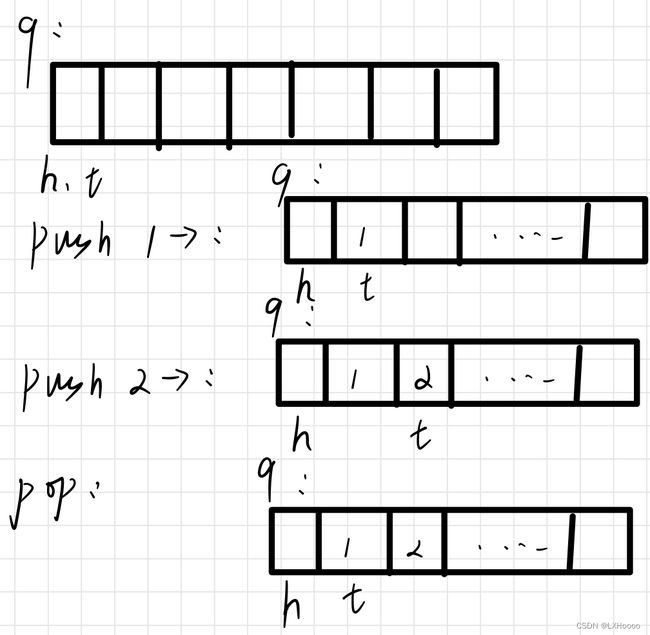
- 题目链接:数组模拟队列
- 代码
#include
#include
using namespace std;
const int N = 100010;
int q[N];
int n;
int hh,tt;
int main() {
scanf("%d",&n);
char opt[5];
int num;
for(int i = 0; i < n; i++)
{
scanf("%s",opt);
if(!strcmp(opt,"push"))
{
scanf("%d",&num);
q[++tt] = num;
}
else if(!strcmp(opt,"pop"))
{
if(hh == tt)
{
printf("error\n");
}
else {
printf("%d\n",q[++hh]);
}
}
else {
if(hh != tt)
{
printf("%d\n",q[hh+1]);
}
else {
printf("error\n");
}
}
}
}
2.2.2、滑动窗口(单调队列的使用)
- 解析:这个问题一般就三步:1、什么时候队头需要前进;2、队头的最大值或者最小值是否要更新;3、什么时候输出或者保存队头的最大或最小值
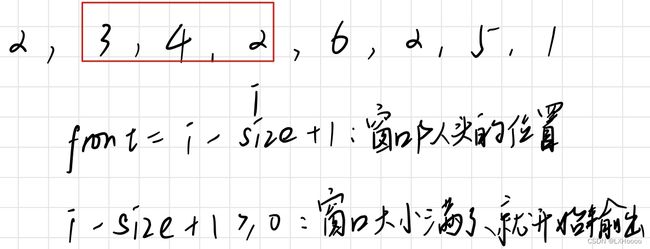
- 题目链接:滑动窗口
- 代码
class Solution {
public:
vector<int> maxInWindows(const vector<int>& num, unsigned int size) {
const int N = 10010;
int n = num.size();
int q[N],front=0,tail=-1;
vector<int>ret;
for (int i = 0; i < n; i++) {
int a = i - size + 1;
if (front <= tail && a > q[front]) front++;
while (front <= tail && num[i] >= num[q[tail]]) tail--;
q[++tail] = i;
if (i >= size - 1) ret.push_back(num[q[front]]);
}
return ret;
}
};
3、KMP(字符串匹配)
#include
#include
using namespace std;
const int N = 500010;
int main() {
string str1,str2;
cin >> str1 >> str2;
char S[N],P[N];
bool flag = false;
for(int i = 0; i < str1.length();i++)
{
S[i+1] = str1[i];
}
for(int i = 0; i < str2.length();i++)
{
P[i+1] = str2[i];
}
int ne[N];
for(int i = 2,j = 0; i <= str2.length(); i++)
{
while(j && P[i] != P[j+1]) j = ne[j];
if(P[i] == P[j+1]) j++;
ne[i] = j;
}
for(int i = 1,j = 0;i <= str1.length(); i++)
{
while(j && S[i] != P[j+1]) j = ne[j];
if(S[i] == P[j+1]) j++;
if(j == str2.length())
{
flag = true;
cout << i-str2.length() << " ";
j = ne[j];
}
}
if(flag)
return 0;
else
cout << -1;
}
4、Trie树(高效地存储和查找字符串集合的数据结构)
- 解析:trie树的存储方式如下所示,从根节点开始,依次找子节点,没有就新创建一个,并在每个单词的末尾打上一个标记,表示这是一个完整的单词
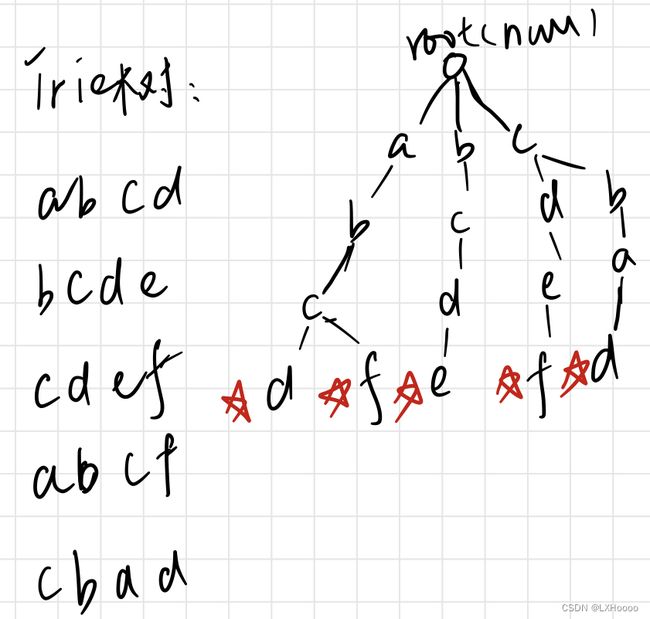
- 题目链接:字典树的实现
- 代码
5、并查集
- 解析:每个集合的根节点就是这个集合的编号,初始每个节点各自为一个集合,合并1,2这两个集合只需要让2作为1的父节点,节点1里面存的就是2这个父节点的值
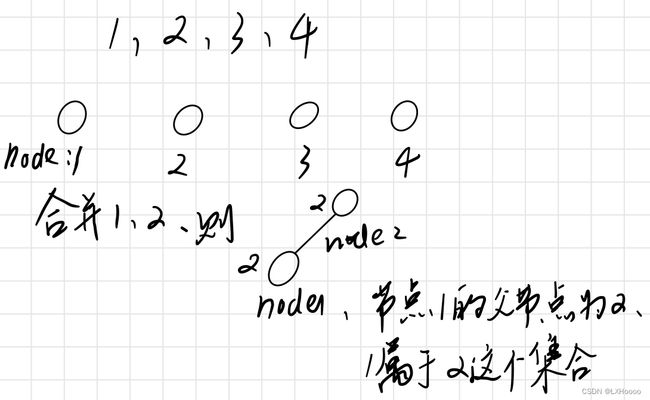
- 题目链接:并查集的实现
- 代码:一下几次提交结果是使用cin和cout以及scanf和printf的结果,大数据量的时候使用cin读入和cout读出特别费时间,所以最好使用scanf和printf以节省时间。
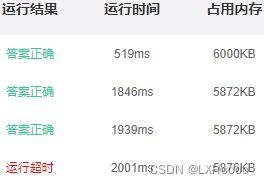
#include
using namespace std;
const int N = 1000010;
int n,m;
int p[N];
int find(int x)
{
if(p[x] != x) p[x] = find(p[x]);
return p[x];
}
int main() {
scanf("%d%d",&n,&m);
for(int i = 1; i <= n; i++)
{
p[i] = i;
}
while(m--)
{
int opt,a,b;
scanf("%d%d%d",&opt,&a,&b);
if(opt == 1)
{
if(find(a) == find(b)) printf("Yes\n");
else printf("No\n");
}
else if(opt == 2)
{
p[find(a)] = find(b);
}
}
}
6、堆
- 解析:整个的原理如下所示,堆本质是一颗完全二叉树,但可以通过数组来实现存储。不管是插入还是删除操作,做完之后都要针对该位置重新更新一下排序
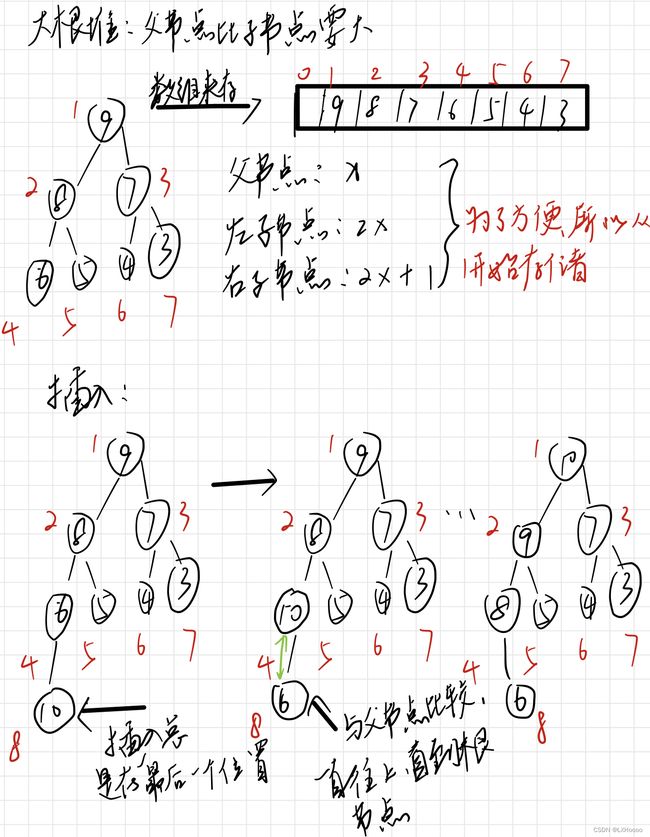
- 题目链接:堆模板
- 代码
#include
#include
#include
#include
using namespace std;
const int N = 100010;
int arry[N],len;
void up(int x)
{
while(x/2 && arry[x] > arry[x/2])
{
swap(arry[x],arry[x/2]);
x >>= 1;
}
}
void down(int x)
{
int t = x;
if(x*2 <= len && arry[x*2] > arry[t]) t = x * 2;
if(x*2+1 <= len && arry[x*2+1] > arry[t]) t = x * 2 + 1;
if(t != x)
{
swap(arry[t],arry[x]);
down(t);
}
}
int main() {
int n;
scanf("%d",&n);
char opt[5];
int num;
for(int i = 0; i < n; i++)
{
scanf("%s",opt);
if(!strcmp(opt,"push"))
{
scanf("%d",&num);
arry[++len] = num;
up(len);
}
else if(!strcmp(opt,"pop"))
{
if(len)
{
printf("%d\n",arry[1]);
arry[1] = arry[len--];
down(1);
}
else {
printf("%s\n","empty");
}
}
else if(!strcmp(opt,"top")){
if(len)
printf("%d\n",arry[1]);
else
printf("%s\n","empty");
}
}
return 0;
}
7、Hash表
- 作用:将一些较大的值域/复杂的数据映射到一个较小的范围(-109~109)->(0,10^5)
- x mod 10^5 ----> (0,10^5)
- 可能会有冲突:通过拉链法或者开放寻址法处理冲突
- 哈希表
- 解析:
7.1、字符串前缀哈希(KMP的劲敌)
8、STL常用容器(用的时候查一下就行了)
8.1、vector
- size和empty所有的都有这个,但clear有的没有
- size():返回元素个数
- empty():是否为空
- clear():清空
- front()/back()
- push_back()/pop_back()
- begin()/end()
- []:随机选址
- 支持比较运算(按字典序)
8.3、pair
- first、second、支持比较运算(以first为第一关键字,second为第二关键字)、
- p = make_pair(10,“lxh”);
8.2、string
- size()/length()
- empty()、clear()
- substr(a,b):返回a开始的长度为b的字串
- c_str():返回string 的首地址
#include
#include
#include
#include
using namespace std;
int main()
{
string s = "lxh";
cout << s.substr(1,2) << endl;
printf("%s",s.c_str());
return 0;
}
8.3、queue(队尾进队头出,固定方向)
- **size()、empty()、没有clear() **
- push():向队尾插入一个元素
- front():返回队头元素
- back():返回队尾元素
- pop():弹出队头元素
8.4、priority_queue(优先队列就是堆,默认是大根堆)
- push():插入一个元素
- top():返回堆顶元素
- pop():弹出堆顶元素
- 定义小根堆
priority_queue<int,vector<int>,greater<int>>hp;
8.5、stack
8.6 deque(双端队列)
8.7 set、map、multiset、multimap(基于平衡二叉树(红黑树),动态维护有序序列)
8.8、unordered_set、unordered_map、unordered_multiset、unordered_multimap(哈希表)
8.9、bitset









